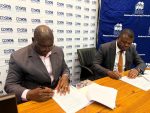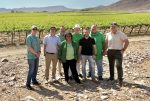Australian junior energy firm Grand Gulf Energy has seen its share price skyrocket by 100% following the announcement of a strategic agreement to enter Namibia’s burgeoning hydrocarbon sector, signaling growing international confidence in the country’s untapped energy potential. The company revealed this week it has secured a binding deal to acquire Wrangel Pty, a move that positions it to obtain a 70% stake in Petroleum Exploration Licence (PEL) 2312, located in the Walvis Basin offshore Namibia. The news has electrified markets, underscoring heightened investor interest in Namibia’s northern basins as exploration activity surges beyond the heavily contested Orange Basin.
The agreement, finalized amid a scramble for exploration rights in Namibia’s offshore zones, highlights a strategic pivot by oil and gas players toward less saturated regions. With major acreage in the Orange Basin—home to Shell and TotalEnergies’ multi-billion-barrel discoveries—already dominated by global giants, junior explorers like Grand Gulf are turning their attention to emerging plays in the Walvis, Lüderitz, and Namibe basins. Grand Gulf’s bold entry into PEL 2312, previously operated by UK-based Chariot, marks a significant bet on Namibia’s northern margins, where geological parallels to neighboring hydrocarbon-rich regions have sparked optimism.
Under the terms of the deal, Grand Gulf gains an option to purchase Wrangel Pty, which has applied to hold a 70% operating interest in PEL 2312. The remaining shares in the licence are split between local firm TSE Oil & Gas (20%) and Namibia’s state-owned National Petroleum Corporation (Namcor) (10%), ensuring domestic participation in line with Namibia’s empowerment policies. While the licence application is still pending regulatory approval, the market’s reaction was immediate: Grand Gulf’s stock doubled on the Australian Securities Exchange, reflecting bullish sentiment around Namibia’s exploration prospects.
Grand Gulf, which has historically focused on helium projects in the United States, described the move as a strategic diversification into “high-impact oil and gas opportunities.” The Walvis Basin, though less explored than the Orange Basin, has attracted attention following recent seismic studies suggesting hydrocarbon potential. Industry analysts note that the basin’s geology shares similarities with Brazil’s Santos Basin, where vast pre-salt reserves were discovered, raising hopes that Namibia’s northern waters could yield similar successes.
“This deal is a vote of confidence in Namibia’s evolving energy narrative,” said a local energy analyst, who requested anonymity due to ongoing projects. “With the Orange Basin crowded and capital-intensive, juniors are carving out niches in frontier areas. Grand Gulf’s leap into the Walvis Basin could catalyze further investment, especially if early exploration confirms resource viability.”
The transaction also underscores Namibia’s growing appeal as a hotspot for both established and emerging energy players. Since Shell’s 2022 discovery of the Jonker-1X well in the Orange Basin, the country has witnessed a surge in exploration applications, with over 20 active licences now spanning its offshore territories. However, as competition intensifies in the south, smaller firms like Grand Gulf are leveraging partnerships with local entities to access opportunities in under-explored zones. TSE Oil & Gas, a Namibian-owned company, and Namcor’s involvement in PEL 2312 align with government mandates to ensure resource wealth benefits local stakeholders through employment, skills transfer, and equity participation.
For Grand Gulf, the high-risk, high-reward nature of offshore exploration is tempered by the potential for outsized returns. The company’s decision to pivot toward oil and gas mirrors a broader trend among helium-focused firms seeking to balance portfolios amid fluctuating commodity prices. Should PEL 2312 progress to drilling, Grand Gulf plans to collaborate with TSE and Namcor to conduct seismic surveys and exploratory drills, though timelines remain contingent on regulatory approvals and funding.
The Walvis Basin’s prospects, while promising, are not without challenges. Exploration in deepwater zones requires significant capital, technical expertise, and patience, with no guarantee of commercial discoveries. Chariot, the previous operator of PEL 2312, exited the licence in 2023 after shifting focus to renewable energy projects, leaving unanswered questions about the block’s viability. Nevertheless, Grand Gulf’s leadership appears undeterred. In a statement, the company emphasized Namibia’s “stable regulatory environment” and “world-class hydrocarbon potential” as key factors in its decision.
Market watchers suggest the stock surge reflects not only optimism about PEL 2312 but also broader enthusiasm for Namibia’s energy sector. The country’s proactive approach to licensing, coupled with its transparency in resource governance, has positioned it as a preferred destination for exploration capital. “Namibia is no longer a hidden gem—it’s a strategic priority for global energy firms,” said an industry insider. “Junior players like Grand Gulf are betting that early entry into frontier basins will pay dividends, especially if larger players follow.”
For Namibia, the influx of exploration activity offers economic promise but also underscores the need for cautious stewardship. The government has faced calls to ensure that local communities benefit from resource extraction, particularly in regions where unemployment and poverty remain acute. Namcor’s 10% stake in PEL 2312, while modest, reflects efforts to anchor resource sovereignty and channel revenues into national development.










